The workshop “Artisans in the Digital Age: My Experience as a Ceramicist” offers participants a unique opportunity to discover how digitalization transformed the world of craftsmanship, through the experience of Pepaflaca, a ceramicist who has successfully combined tradition and innovation. During the workshop, Pepaflaca will share her professional journey and explain how she managed to gain recognition on social media. Through the use of digital platforms, she found a way to showcase her creative process, build a network of contacts and promote her work, reaching a global audience. Participants will have the chance to learn how to leverage digital technologies to increase visibility and tackle the challenges of the online world, while always maintaining their artistic identity. It’s an opportunity to reflect on how artisans can navigate the digital world without losing their authenticity.
Padiglione: Spadolini Pavilion - Ground Floor
Creation of a small handcrafted piece with the valuable guidance of an artisan who will share the fundamental techniques of alabaster working
Creation of a small handcrafted piece with the valuable guidance of an artisan who will share the fundamental techniques of alabaster working
Master Craftsman Massimo Baicchi will hold a workshop dedicated to graphic arts, their history and their importance in the spread of culture. The technique of engraving became prominent in the 15th century when book printing gained widespread use, and the need arose to produce multiple copies of the same image. Participants will understand how freehand drawing is transformed into the creation of a mold, which is then manually engraved so it can be used to transfer the drawn image into paper using a printing press and ink. From a single mold, it is possible to obtain a variable number of prints, depending on the material and the techniques used to create the mold.
Master Craftsman Massimo Baicchi will hold a workshop dedicated to graphic arts, their history and their importance in the spread of culture. The technique of engraving became prominent in the 15th century when book printing gained widespread use, and the need arose to produce multiple copies of the same image. Participants will understand how freehand drawing is transformed into the creation of a mold, which is then manually engraved so it can be used to transfer the drawn image into paper using a printing press and ink. From a single mold, it is possible to obtain a variable number of prints, depending on the material and the techniques used to create the mold.
During the demonstration, the art of Florentine commesso mosaic will be introduced, from its origins to the most contemporary creations. The technique will be demonstrated, especially during the main stages of cutting and assembling, while explaining the search for materials as they are found in nature. The audience will have the opportunity to experiment with cutting using a bow saw to discover the challenges and secrets of the ancient craft of ‘hard stones’ working.
During the demonstration, the art of Florentine commesso mosaic will be introduced, from its origins to the most contemporary creations. The technique will be demonstrated, especially during the main stages of cutting and assembling, while explaining the search for materials as they are found in nature. The audience will have the opportunity to experiment with cutting using a bow saw to discover the challenges and secrets of the ancient craft of ‘hard stones’ working.
Bring your old hat and, together with Ilaria Creazione Cappelli, you will give it a new life by personalizing it with creative and imaginative decorations. You will use recycled materials from textile companies in Prato. You can also bring personal items such as flowers, jewelry, shells, buckles, ribbons or anything else you wish to adorn your hat with
The art of paper-mâché was profoundly innovated by the masters of the Viareggio Carnival. In 1925, in this Tuscan city, the technique of paper-mâché was perfected, allowing the construction of the large floats that parade every year during the Carnival. During the workshop, Master Craftsman Marzia Etna will show some techniques for working with and decorating paper-mâché. Clay models, chalk molds, newspaper and glue, made from water and flour, are the ingredients for creating not only masks but also decorations and household objects.
Master Craftsman Stefano Parrini will hold a workshop dedicated to leather and the techniques for working with natural leather. Leather is shaped into forms to create objects of all kinds. Some of the artisanal techniques from tradition will be illustrated, which have their roots in ancient Rome and the Renaissance, contributing to making Italian leather goods of the highest quality. Among such techniques: those for preparation, dyeing, shaping, cutting and hand stitching. Part of the workshop will be dedicated to the importance of design and the culture of craftsmanship in leather goods. The use of new machinery and materials, innovations and market demands have made design a central element. Ancient artisanal traditions are used to create products that combine quality, aesthetics and functionality



